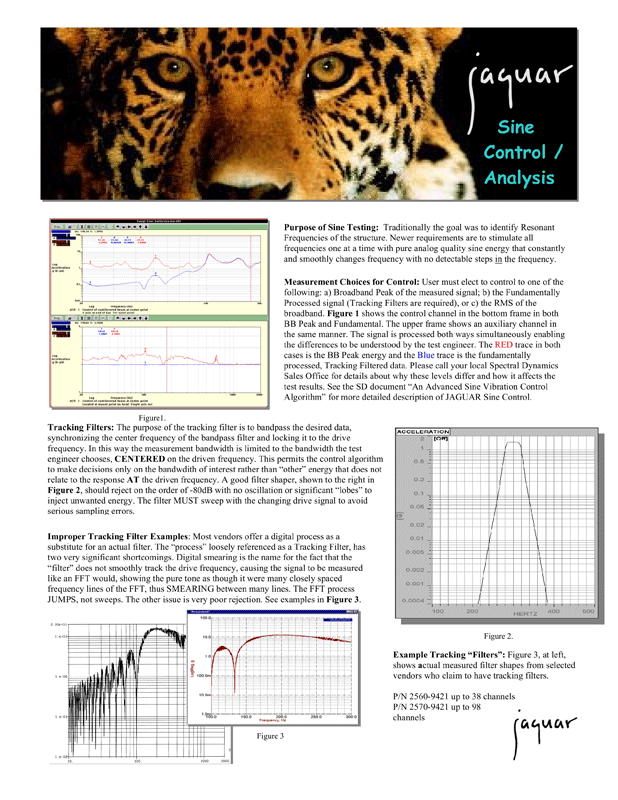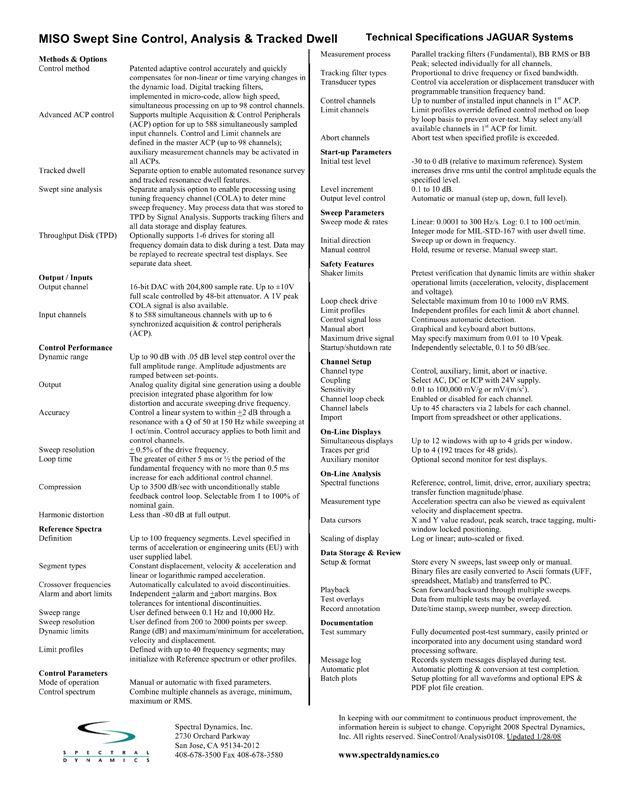Sine Control / Analysis
Swept Sine testing is done to determine resonant frequencies and damping factors, overall peak G response of the structure to stimulus, or simply to adhere to a test requirement. Whatever your needs are, JAGUAR establishes new levels of performance.
Testing large structures that possess closely spaced, highly responsive resonant characteristics poses a severe challenge to a digital control system.
The traditional approach is to attempt to sweep rapidly through a resonance, in the hope that damage can be avoided. This makes resonance definition very difficult. Traditional systems typically lack adequate control dynamic range to allow excitation of the resonance yet maintain control. The risk of damage makes this undesirable.
JAGUAR solves these problems with a combination of purpose built hardware, powerful DSP on each input and output channel, and a long engineering appreciation for the intricacies of sine testing. Some specifics of performance follow:
- Output attenuator control performed in steps as small as 0.05 dB. This fine amplitude control provides a high degree of accuracy to protect critical test articles, especially at the peak of resonance.
- Anti-imaging protection in the output section such that out-of-band energy is attenuated 96 dB. Prohibiting energy from being output to the shaker that was not intended to be output prevents over/under- test conditions.
- Phase matching between channels, without resorting to software compensation, which is typically less than 0.01 degree. A powerful feature of JAGUAR is its ability to generate H(f) during the test and display them as they build. This is a potent analysis tool that greatly aids in pre-modal testing and resonance definition.
- Extremely powerful 32 bit floating point DSP which equips each input channel with the world ’s only patented digital tracking filter. True Tracking Filters during analysis and/or control ensure that ONLY the response energy desired is considered in measurement and control strategies. High quality Tracking Filters also prove invaluable in determining the peak G, Q, Phase and true frequency of resonant and anti- resonant conditions.
Hardware specifications matter because software cannot compensate for the failures of hardware. Without JAGUAR ’s 32 bit DSP for each channel pair, “tracking filtering ”would be performed using a sliding FFT process that allows the frequency information to be extracted with amplitude values from a small slice of time data. Because FFTs force even spacing of spectral lines, there will be averaging of energy for each spectral line of the FFT. Causing the fundamental signal source to change its frequency further compounds this undesirable attribute. Digital smearing occurs, which amplifies the scale of the error. The result is that the fundamental response is “averaged ” across multiple FFT bins, causing extremely poor peak definition and Q estimates. Peak definition is valuable because it helps identify the resonant frequency.
The FFT approach greatly hampers sine control and significantly reduces the accuracy of resonance measurements.
JAGUAR ’s true Tracking Filters eliminate all of the problems created by using an FFT based process. The result is the ability to actually control through resonance which yields a very accurate description of the resonance. It also ensures that the test article is neither over-nor under tested. Both conditions typically occur with FFT-based “tracking filters. ”
Adaptive control greatly enhances the accuracy and speed with which JAGUAR performs Sine and Random tests. JAGUAR ’s unique combination of low internal signal noise, optimum data window choices and advanced processing power permits a very large percentage of error correction per loop while maintaining control stability. Within the Aerospace community, JAGUAR is acknowledged as the premier Sine Control system in the world.
Sine Control / Analysis Product Brochure & Technical Specifications
| (click to expand) | ||
 |
 |
|
 Download as PDF Download as PDF |










